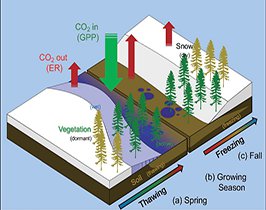Projects
NASA Interdisciplinary Research in Earth Science (IDS)

Warmer springs and drier summers are expected to increase the CO2 uptake of terrestrial ecosystems by lengthening the growing season, but reduce summer uptake through water stress. One of the key challenges in carbon cycle science is determining the balance of these processes, how they are coupled through carbon-water cycle interactions, and the impact on atmospheric CO2 concentrations. The carbon uptake response to seasonal warming and drying is uncertain, but appears to be increasingly dependent on availability of liquid water in soils, which is limited primarily by water scarcity in warm temperate climates and freezing temperatures in cold northern climates, and modulated by drought and thawing/freezing processes, respectively. Their interactive effects with CO2 photosynthetic gain (GPP) and respiration loss (ER) shows high seasonal, spatial, and biome dependence.
Here, we propose to exploit an expanding set of multi-scale carbon and water cycle observations with state-of-the-art land and atmosphere models to investigate the response of seasonal phenology, CO2 exchange, and atmospheric CO2 to spring warming, soil thaw, and liquid water availability since 2002. We will use a coupled hydrosphere-biosphere-atmosphere analysis framework, focusing broadly on North America (NA) and specifically on climate sensitive semi-arid and arctic-boreal ecosystems. We seek to answer the following critical science question:
"How has terrestrial carbon uptake, in particular GPP and ER, evolved in the past decade, and what has been the impact on atmospheric CO2 concentrations?"
Our work leverages new and existing tower measurements of solar induced chlorophyll fluorescence (SIF) in NA to exploit NASA’s unique array of satellite vegetation remote sensing data to
- establish the mechanistic relationship between SIF and GPP across diverse biomes as a function of optimized light use efficiency (LUE) and SIFyield parameters, and
- refine and calibrate existing (SCIAMACHY, GOSAT, GOME-2, OCO-2) and planned (TROPOMI) satellite SIF observations for broader integrated analysis of long term variability. We will incorporate SIF optimized LUE with observed environmental thresholds (SMAP, AMSR) and vegetation constraints (MODIS) into the SMAP carbon model (L4C) to elucidate structural (EVI), functional (SIF), and environmental (soil moisture, freeze/thaw, vapor pressure deficit, temperature) controls on seasonal component CO2 fluxes (GPP, ER) and annual CO2 balance (NEE) in NA.
We will evaluate SMAP CO2 fluxes against independent constraints from upscaled flux tower data (FLUXCOM), and propagate to atmospheric CO2 for validation (GOSAT, OCO-2, NOAA) and analysis of long term (2002-2018) IAV of CO2 annual growth and seasonal cycle amplitude. We will also incorporate our findings into the prognostic Community Land Model (CLM) by parameterizing phenological processes (time lag between leaf out and photosynthetic onset) and testing the impact on seasonal CO2 flux and summer water availability.
This investigation is captured in three objectives:
- Quantify 2002-2018 interannual variability in spring and fall phenology, CO2 fluxes, and atmospheric CO2 in North America associated with spring warming and summer drying;
- Identify the critical water availability thresholds that shift the balance of photosynthetic and respiration CO2 fluxes in vulnerable, climate sensitive biomes; and
- Demonstrate the power of combining strategically coordinated tower SIF measurements with NASA satellite SIF and CO2 products to monitor spatial and temporal GPP variations.
